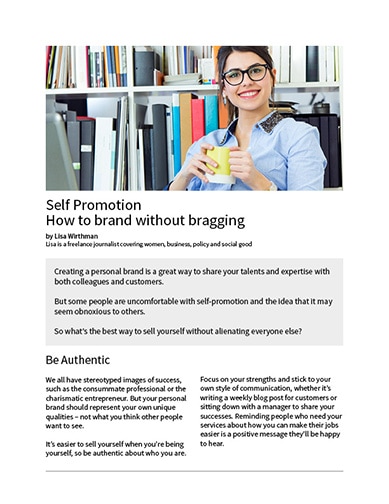How to brand without bragging
by Lisa Wirthman
Lisa is a freelance journalist covering women, business, policy and social good
Lisa is a freelance journalist covering women, business, policy and social good
Be Authentic
We all have stereotyped images of success, such as the consummate professional or the charismatic entrepreneur. But your personal brand should represent your own unique qualities – not what you think other people want to see.
It’s easier to sell yourself when you’re being yourself, so be authentic about who you are. Focus on your strengths and stick to your own style of communication, whether it’s writing a weekly blog post for customers or sitting down with a manager to share your successes. Reminding people who need your services about how you can make their jobs easier is a positive message they’ll be happy to hear.
Stick to the Facts
Focus on facts and not interpretation, writes marketing strategist and author Dorie Clark in Harvard Business Review. It’s hard to argue with the facts if you say that you have a decade of experience in your field, a passion for what you do, or a certain number of social media followers, says Clark.
But calling yourself a guru, an expert, or a ninja is another story, she adds. Don’t invite criticism by trying to characterize your skillset. Do stick to the facts by describing what you have done -- and what you can do -- to help others. Providing relevant examples is a great way to drive those points home.
Share the Credit
When sharing your accomplishments, don’t be shy about sharing the credit with those who deserve it as well. A willingness to promote others indicates confidence in your own abilities.
“In my experience, glad-handing self-aggrandizement is rarely an effective technique,” says entrepreneur and author Seth Godin in an interview with the New York Times. “What works instead is a combination of relentlessly giving away credit and generously taking responsibility,” he advises.
Rather than focusing on entitlement, this approach focuses on your engagement with your work, he explains. Or in in other words: “Successfully tooting your own horn is more about the horn than the tooting,” Godin says.
We all have stereotyped images of success, such as the consummate professional or the charismatic entrepreneur. But your personal brand should represent your own unique qualities – not what you think other people want to see.
It’s easier to sell yourself when you’re being yourself, so be authentic about who you are. Focus on your strengths and stick to your own style of communication, whether it’s writing a weekly blog post for customers or sitting down with a manager to share your successes. Reminding people who need your services about how you can make their jobs easier is a positive message they’ll be happy to hear.
Stick to the Facts
Focus on facts and not interpretation, writes marketing strategist and author Dorie Clark in Harvard Business Review. It’s hard to argue with the facts if you say that you have a decade of experience in your field, a passion for what you do, or a certain number of social media followers, says Clark.
But calling yourself a guru, an expert, or a ninja is another story, she adds. Don’t invite criticism by trying to characterize your skillset. Do stick to the facts by describing what you have done -- and what you can do -- to help others. Providing relevant examples is a great way to drive those points home.
Share the Credit
When sharing your accomplishments, don’t be shy about sharing the credit with those who deserve it as well. A willingness to promote others indicates confidence in your own abilities.
“In my experience, glad-handing self-aggrandizement is rarely an effective technique,” says entrepreneur and author Seth Godin in an interview with the New York Times. “What works instead is a combination of relentlessly giving away credit and generously taking responsibility,” he advises.
Rather than focusing on entitlement, this approach focuses on your engagement with your work, he explains. Or in in other words: “Successfully tooting your own horn is more about the horn than the tooting,” Godin says.
| Stay Humble A great way to make sure your message is well received is to give more than you ask, writes Julie Parker, founder of an online training school for life coaches. Empowering others through your work is a great way to develop a reputation for being both smart and strategic, she says. Then when it’s time to ask for that dream promotion or close a big sale, you can do so knowing that the value you’ve provided to others gives you the right to ask for more, Parker advises. It’s also important to remember that being humble doesn’t mean hiding your skills – only being sensitive about how you share your accomplishments. In short, learning how to brand without bragging is a great way to advertise what you can do and to help others succeed by using you as a resource. It's a win-win for all involved -- and a message worth sharing. |





 RSS Feed
RSS Feed

